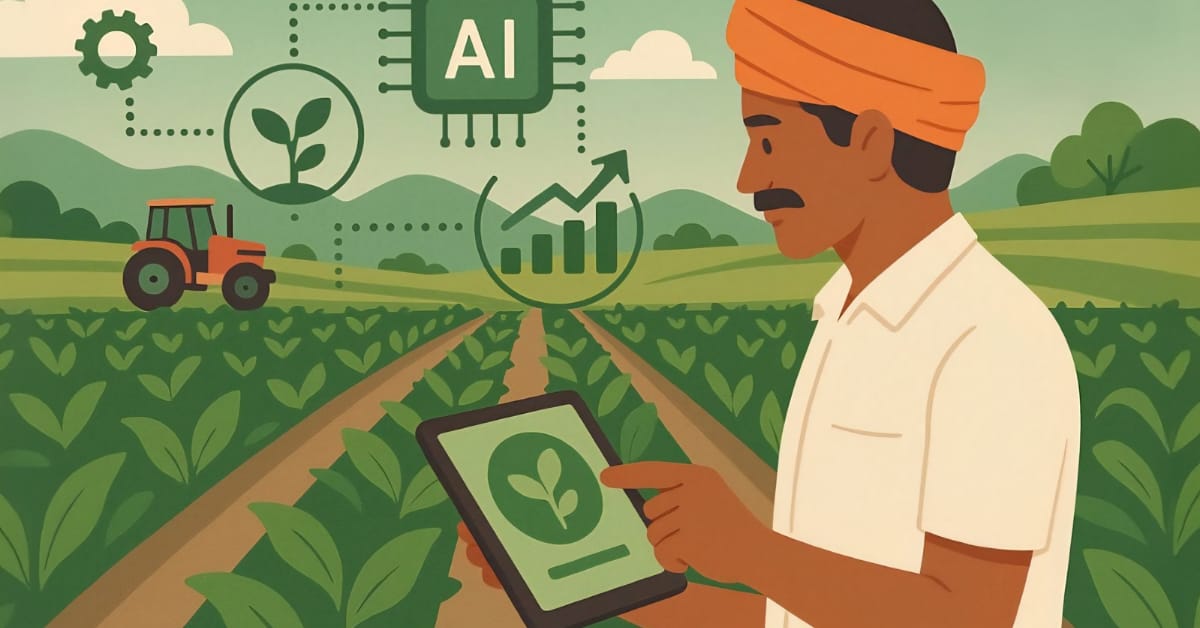Ministry of Electronics and Information Technology (MeitY) has launched a path-breaking electronics and AI based solutions under AgriEnlcs Programme, a giant step towards Aatmanirbhar Bharat
A major step towards technological independence was taken by MeitY by transferring four advanced agricultural technologies and initiating a novel environmental monitoring system. S. Krishnan’s dream of “electronics and sensor-based innovations creating tangible impact in common man’s daily lives” is now becoming a reality from policy to action.
From labs to fields: The AgriEnIcs success story
Imagine a rural Punjab dairy farmer looking at his smartphone early in the morning, getting real-time notifications regarding the health of his cattle. Imagine a Food Corporation of India warehouse grain inspector scanning thousands of kilograms of pulses in minutes, not days. This is not a vision for the future—it’s the current reality being made possible by India’s AgriEnIcs programme.
The national programme, led by C-DAC Kolkata with collaboration from top institutions such as IIT Kharagpur, ICAR-NDRI, and ICAR-IARI, is a revolution in the way technology converges with agriculture. Success of the program lies not only in the development of solutions, but that they are made affordable, scalable, and tailor-made for Indian conditions.
Revolutionary dairy solutions: A game changer for cattle breeders
The Electronics-based Dairy Solution package—now shifted to Handholders Global, Bhubaneswar—addresses two severe issues assailing India’s humongous dairy industry. The Go-P wearable collar detects cattle physiological temperature to forecast ideal artificial insemination timing with incredible accuracy. For breeders who hitherto depended on eyeball test and guesswork, this IP67-rated gadget is nothing less than revolutionary.
Accompanying this is MAST-D, an electrochemical mastitis detector that can detect infections in cattle milk within minutes. Given that mastitis results in significant economic losses in dairy farming, this quick and affordable solution could make the industry millions of dollars while providing milk quality to consumers.
Smart quality control: Grain-Ex, CT-VIEU, and RIGE-Sense
Agenext Technologies Private Limited, Punjab, has acquired three sophisticated quality analysis systems that promise to revolutionise grain inspection. The Grain-Ex system employs AI-powered digital image processing to analyze pulses, wheat, and sorghum, automatically identifying immature grains, damage, and foreign matter—tasks that traditionally required skilled inspectors and considerable time.
The CT-VIEU for red chilli quality evaluation employs conveyorized imaging with segmented frame analysis, avoiding redundant processing while preserving accuracy. Most striking is RIGE-Sense, which solves a century-old problem of rice quality estimation. By substituting computer vision and machine learning for the subjective Mixed Indicator Method, it offers objective, real-time evaluation of rice age—vital for Public Distribution System operations impacting millions of beneficiaries.
Environmental champion: ODORPravah addresses municipal waste issues
The introduction of ODORPravah, a sensor-enabled odour monitoring device, brings focus to the usually neglected but crucial concern of ambient air quality near municipal solid waste facilities, industrial processing units, and landfills. With photonization detectors and electrochemical sensors, the lightweight, handheld system offers real-time measurement of odour-contributing gases, facilitating regulatory compliance as well as public health protection in India’s fast-growing urban environment.
The way forward: Markets, data, and sustainability
The Secretary Krishnan’s focus on “data-driven, market-based models” heralds a high level of maturity that technology transfer is only the starting point. The true challenge is in adoption, scaling, and devising sustainable business models around these innovations. That private sector partners such as Handholders Global and Agnext Technologies are involved hints at a promising business route.
Seeds of self-reliance
These technology transfers are not just scientific milestones—they reflect India’s path towards Aatmanirbhar Bharat. By tackling actual-world farm and environmental problems with homegrown solutions, the AgriEnIcs programme proves self-reliance is not isolation but developing capabilities to address
India’s specific requirements. As these technologies become available to farmers, inspectors, and environmental managers nationwide, they have the power to increase productivity, improve economic returns, and enhance living standards—just the real effect Secretary Krishnan had in mind. The issue now isn’t if India can innovate, but how quickly these innovations can scale to change millions of lives.









